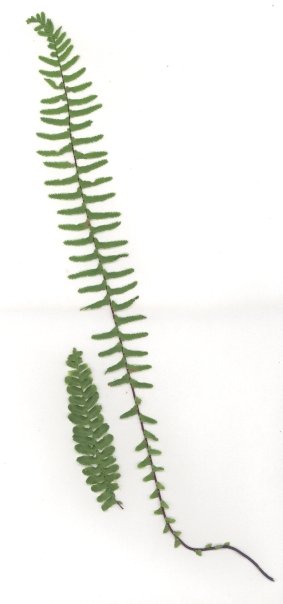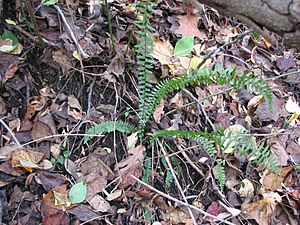Ebony spleenwort facts for kids
Quick facts for kids Ebony spleenwort |
|
|---|---|
 |
|
| A. platyneuron fronds; the smaller frond on the left is sterile, the longer frond on the right is fertile. | |
| Conservation status | |
| Scientific classification | |
| Genus: |
Asplenium
|
| Species: |
platyneuron
|
| Synonyms | |
|
Acrostichum platyneuros L. |
|
The Ebony Spleenwort (scientific name: Asplenium platyneuron) is a type of fern. It gets its common name from its dark, shiny stem, which looks like ebony wood. This fern is found in eastern North America, especially east of the Rocky Mountains.
This fern has two kinds of leaves, called fronds. The fronds that produce spores are dark green and stand straight up. They die in the winter. The other fronds are lighter green and stay flat on the ground all year. These are called sterile fronds. Each small leaflet on the frond has a tiny ear-like part at its base. This helps tell it apart from other similar ferns.
Ebony spleenwort can grow new plants in cool ways. It can form small buds near the base of its stem. If these buds get covered with soil, they can grow into new ferns. It also spreads easily by spores. The tall, upright fronds help the spores catch the wind and travel far. This has helped the fern spread quickly in places like the Great Lakes region. It has even been found in South Africa and Slovakia, far from its usual home.
Unlike many other ferns, ebony spleenwort can grow in many different places. It grows on rocks, but also in various types of soil. It is not very picky about how acidic or alkaline the soil is. This fern can also mix its genes with other spleenwort ferns. This creates new types of ferns, which are part of a group called the "Appalachian Asplenium complex."
Contents
What it Looks Like
Ebony spleenwort is a small fern that grows in clumps. Its stems and main leaf stalks are shiny and reddish-brown. The fronds (leaves) are divided into many small leaflets.
Stems and Leaves
The stem of the fern, called the stipe, is usually 1 to 10 centimeters (0.4 to 4 inches) long. It is shiny and dark reddish-brown. The main part of the leaf, called the blade, is long and narrow. It can be from 4 to 50 centimeters (1.6 to 20 inches) long. The blade is shiny and usually smooth.
The main stalk of the leaf, called the rachis, is also dark and shiny. The leaf blade has 15 to 45 pairs of small leaflets, called pinnae. These pinnae are arranged alternately along the rachis. Each pinna is somewhat rectangular and has a small ear-like lobe at its base. The edges of the pinnae can be slightly toothed.
Spores
On the underside of the fertile fronds, you can find small brown clusters called sori. These sori contain tiny cases called sporangia, which hold the fern's spores. Each sporangium has 64 spores. The spores are light to dark brown and have a spiny, netted pattern on their surface.
New Plants from Buds
Ebony spleenwort can make new plants from small buds that grow on the main leaf stalk near the base. These buds are pale and button-like. If they touch the soil, they can grow roots and leaves, forming a new fern plant. This is a way for the fern to spread without using spores.
How to Identify It
Ebony spleenwort looks similar to the black-stemmed spleenwort. However, the black-stemmed spleenwort has darker stems and its leaflets are opposite each other, not alternate. Maidenhair spleenwort also has a dark stem, but its leaflets are more oval-shaped. Unlike these other ferns, ebony spleenwort has two different kinds of fronds: upright fertile ones and flat sterile ones.
Sometimes, young ebony spleenworts might be confused with young Christmas ferns. But Christmas ferns are usually much larger and have green, scaly stems.
Naming and History
This fern is commonly called "ebony spleenwort" because of its dark, shiny stem.
The first scientific name for this fern was given by Carl Linnaeus in 1753. He called it Acrostichum platyneuros. Later, in 1789, another scientist named William Aiton gave it a different name, Asplenium ebeneum, which means "ebony-like." For a long time, most botanists used the name Asplenium ebeneum. However, in the late 1800s, scientists decided to use Linnaeus's original name, Asplenium platyneuron, because it was published first.
Over the years, some scientists tried to put this fern into different groups, but these ideas were not widely accepted. Today, it is still known as Asplenium platyneuron.
Different Forms
Scientists have described a few different forms of ebony spleenwort. Some forms have more deeply cut leaflets, or are larger and produce more spores. However, most of these differences are just natural variations within the species. They are not usually considered separate types of ferns anymore.
Two special forms are still sometimes recognized:
- A. platyneuron f. hortonae: This form has very deeply cut leaflets and is usually sterile (does not produce spores).
- A. platyneuron f. furcatum: This form has fronds that split or fork near the tip.
Hybrids
Ebony spleenwort can create hybrids (mixes) with other spleenwort ferns. This happens when two different fern species cross-pollinate. These hybrids are often sterile, meaning they cannot produce their own spores. However, sometimes these hybrids can double their chromosomes and become fertile, forming a new species.
For example, ebony spleenwort can hybridize with:
- Mountain spleenwort: This hybrid can lead to a fertile species called Bradley's spleenwort.
- Walking fern: This hybrid is called Scott's spleenwort. In some places, Scott's spleenwort has become fertile, forming Tutwiler's spleenwort.
- Lobed spleenwort: This hybrid is known as Kentucky spleenwort.
Ebony spleenwort can also hybridize with other ferns outside of this main group, like wall-rue and maidenhair spleenwort.
Where it Lives
Ebony spleenwort is native to eastern North America. It grows from southern Maine down to Florida and west to states like Nebraska and Texas. It is also found in a small part of southeastern Canada.
Interestingly, this fern is also found in southern Africa, which is unusual for a North American fern. It grows in countries like South Africa and Lesotho. In 2009, an isolated group of these ferns was even found in Slovakia, Europe. Since the 1960s, ebony spleenwort has been spreading quickly in the Great Lakes region, where it used to be rare.
Habitat
Ebony spleenwort can live in many different places. It grows at various elevations, from sea level up to 1,300 meters (about 4,265 feet). It can handle many soil types, from slightly acidic to slightly alkaline.
Unlike many other spleenworts, it can grow directly in soil, not just on rocks. When it grows in soil, you can find it in forests, woodlands, and even in old fields. It also likes to grow on different kinds of rocks, especially those with calcium. It can even grow on old stone walls. In South Africa, it prefers similar places, often found under small bushes or on rocky banks. It usually grows in partial shade, not in full sun or deep shade.
How it Survives
Ebony spleenwort has some special features that help it survive and spread. It can tolerate dry periods, but it needs soil that drains well. Its young plants can also survive drought for up to a month.
This fern is a good colonizer, meaning it can quickly move into new areas. It can grow in many different soil conditions and in both sun and shade. The starchy bases of its stems store energy, helping it grow fast in the spring. The upright fertile fronds help its spores travel far on the wind. And the buds that grow new plants allow it to spread locally in moist areas. These features help ebony spleenwort be one of the first plants to grow in disturbed places, like old coal mining sites. Its appearance in Slovakia, thousands of miles from North America, shows how far its spores can travel!
While common overall, ebony spleenwort is considered rare or endangered in some states and provinces at the edges of its range in North America.
Growing it at Home
Ebony spleenwort is sometimes grown in terrariums or gardens. It can grow in sandy soil, gravelly soil, or regular potting mix. It doesn't mind if the soil is acidic or alkaline, but it needs good drainage. It can even grow in dry soil. Partial sun or medium to bright light is best, but it can also handle full shade. Once established, these ferns are usually easy to care for.
Images for kids





